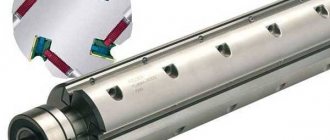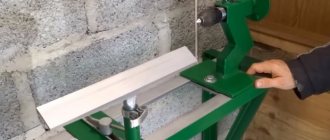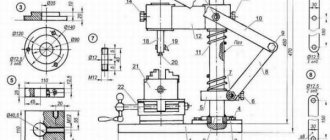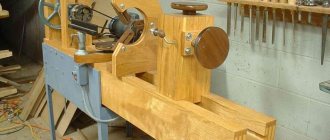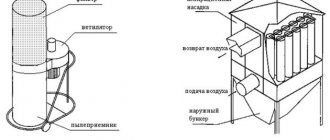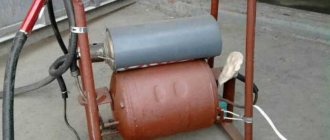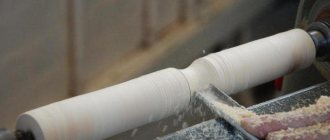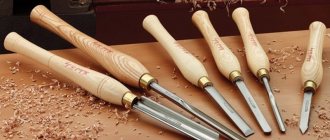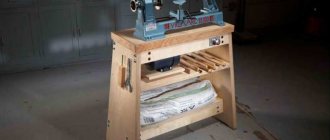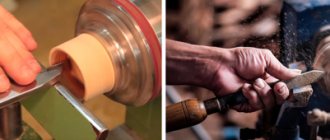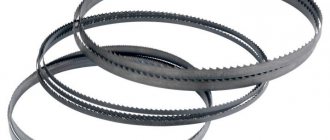In a home workshop, it often turns out that in addition to the existing tool, the smallest thing is missing - a lathe. And it’s not that wood crafts require perfectly cylindrical or spherical parts, it’s just that sometimes you want to do something that has been planned for a long time. So the thought arises, what if you make a wood lathe with your own hands, such a small machine that will take up little space and make it convenient to work with.
The device of a wood lathe
Sooner or later, almost every craftsman begins to get sick of the idea of assembling his own wood turner. Some come to this on their own, after much calculation and thought, while others remember their childhood, and the school workshop there also had woodworking machines. And it’s not difficult to assemble a woodworking machine in the image and likeness of a school one. After all, you can certainly find material in the form of pipe sections in the garage.
The first step is to remember all the main parts of the design of that same school wood lathe. There seem to be few parts here, but each of them plays a specific role, without which everything turns into a pile of scrap metal.
The basis of any machine is the bed. This is a massive base on which all other equipment is mounted. The bed must be as strong and rigid as possible; during operation it must withstand heavy loads not only in the form of a massive workpiece, but also in the form of vibration and the action of multidirectional forces when processing a wooden workpiece.
The headstock of a lathe is a device in which the drive shaft is mounted. On one side of the shaft, a workpiece clamping device is installed - a self-centering lathe chuck, a faceplate or a device onto which a wooden workpiece is screwed or hammered. On the other side of the turning shaft, a drive gear is attached, a pulley with one or more grooves for a belt drive. The turning shaft must provide rotational motion at a speed of up to 3000 revolutions; this is enough for domestic needs. Therefore, the turning shaft is usually mounted on bearings or bushings. The shaft axis is the main axis of the lathe, and the higher the shaft is above the bed, the larger the diameter of the workpiece can be machined. The processing of parts on the machine is carried out using hand cutters, and given the speed of rotation of the shaft, careless touching the pulley or belts can cause injury, so the front assembly must be covered with a protective screen or casing. Rigid fastening of the protection to the headstock is a prerequisite for safe operation.
The tailstock is installed on the opposite side. This is a rigid stop, with a cone-center, which is located exactly along the axis of the turning shaft. The center can move along the axis to secure the workpiece. To fix the position of the center, it is necessary to provide a mechanism for its fixation.
When working on a lathe, hand tools are used. In order not to keep them suspended, a support is installed between the front and rear headstock - a stop for the incisors.
To rotate the working shaft, a drive is installed; it can be an electric motor with direct or belt drive, or it can be driven by muscle power. By the way, the first wood lathes were manually driven - like a bow saw, but later they were replaced by a foot drive.
Advantages of combined universal woodworking machines D300, D400 and other models
Like any other equipment, multifunctional woodworking machines are not without both advantages and disadvantages. Below we will try to understand the advantages of purchasing such a machine and consider the possible disadvantages.
Universal combined woodworking machine D300 F1300 with jointer and thicknesser unit
Disadvantages of household machines:
Helpful advice! Before purchasing, think about the functionality of the machine you need. Analyze the model you like: perhaps the features it lacks can be easily replaced using hand tools. This option is especially convenient if you plan to use the missing functions not too often.
Woodworking machines allow you to create unique objects from wood without spending a lot of effort and time
Selecting a transfer method
In most homemade wood lathes, the working drive is provided by the two most popular methods - direct transmission or through belts. Both schemes are excellent for small-sized lathes with primitive devices for clamping a wooden workpiece in the form of a trident and a cone.
Direct transmission
This is a simple and effective way to drive a turning shaft. The actual working shaft here is the rotor shaft of the electric motor. The engine itself is attached to the frame or raised above the support. A clamping device is installed on the axle - a lathe chuck, a faceplate or a regular trident. This is, in principle, the whole scheme of direct drive of a lathe. The advantage of this scheme is that there is no need to look for a special turning shaft, grind out supports for it and center it. In the motor housing, the shaft is already mounted on bearings, and the engine itself has standard mounting units. The disadvantage of this scheme is that it is necessary to protect the windings from dust and shavings that will form during wood processing, and also, if you clamp the workpiece too tightly, there is a risk of the motor jamming and failure.
In addition, direct transmission does not allow adjustment of the speed. If the engine produces 1425 rpm, then the workpiece will also rotate, alas, this is clearly not enough for turning hardwood.
Belting
The design of the headstock using a belt drive significantly expands the capabilities of the lathe. Even if a pulley of the same diameter is used, this makes it possible to increase the shaft rotation speed and protect the electric motor from heavy loads; in this case, it is definitely not in danger of jamming.
If a multi-lane pulley is mounted on the working shaft, and the engine is mounted on a movable slide, then it becomes possible to regulate the speed of rotation of the shaft by moving the belt from a smaller diameter to a larger one. This is the best option; it makes it possible to process wood of a wide variety of species.
Technical principles
You should also take into account the basic technical rules that are mandatory when creating an individual project.
When developing the supporting part of the tool (this is the bed, or working surface), the dimensions of the table are taken into account, where the following components will be located:
Machine bed diagram
When installing the processing unit, the correspondence of the cutters (this can be a saw, jigsaw, drill) with the capabilities of the drive used is determined.
If you need to change the speed and rotation frequency of the main cutter, you should calculate the installation of the control unit. This can be a manual, automatic or semi-automatic module. It is possible to install a CNC unit yourself if the drawing of the machine is done professionally.
Having studied the structure of production machines for wood processing, you can quickly design a simple unit yourself. Using home woodworking tools, you can not only repair floors or furniture, but also create a new interior.
Motor selection
The electric motor is selected depending on the power and size of the workpiece being processed. To work with workpieces longer than 50 cm and with a diameter greater than 10, it is recommended to choose a motor with a power of 300-400 watts. For small portable wood saws, a power rating of 80-180 watts is recommended. For mini versions used by modellers, motors with a power of 40-60 watts are also suitable.
Important parameters are also the number of revolutions and the type of voltage for operating the motor. In a home workshop, it is better to have an asynchronous motor operating from a 220-volt household network, but for large lathes for serious tasks, it is better to opt for powerful three-phase motors connected to an industrial network. For direct transmission, high-speed motors are usually used. And for a belt drive it is better to install a motor with a standard 1420 rpm.
How to choose the right model
The selection of a suitable model of a multifunctional machine is made based on a combination of several factors:
When considering the option of interest, you need to pay attention to the number of knives on the planing shaft. The more there are, the cleaner the surface, but the more difficult it is to install and configure. In addition, you need to check what the spindle rotation speed is (if there is a milling function), the rotation speed of the knife shaft and saw blade.
Each of them has its own requirements - for a cutter, a speed of 5-6 thousand rpm is recommended, but for a saw blade, more than 3 thousand rpm is not recommended - the tool overheats and begins to dangle in the cut, which is fraught with undesirable consequences.
Woodworking combination machines are useful and effective equipment for the home workshop. With their help, you can make any wooden products, from simple furniture to fence slats or slats for a greenhouse. The quality and composition of products are limited only by the skills and experience of the master, but not by the capabilities of the equipment.
Materials and components
Metal is usually used to construct machines, but as practice shows, you can assemble a small lathe from improvised means, for example, pieces of plywood, wooden blocks and metal plates.
The simplest and most successful material for work is plywood; it is a strong and lightweight material that can withstand heavy loads. It’s not for nothing that plywood is used to build airplane fuselages, and if it can withstand overloads there, then it can withstand the overload as the main material for a lathe.
Connections can be made using furniture bolts, confirmat, self-tapping screws. Strengthening the structure can be done using furniture steel plates.
To come in
Already registered? Sign in here.
There are currently 0 users on the page
There are no users viewing this page.
Electric motors
are the main components of many mechanisms. The offered devices are ideal for driving woodworking machines. They are distinguished by high quality and reliability. The service life under normal conditions is about 10-15 years.
We always have various types of electric motors in stock.
The main advantages of these devices:
Electric motors
allow you to save a lot of money. After all, they do not run on gasoline, but consume electricity. They do not require special care. Customers who have purchased this product from us leave only positive feedback.
Cost of electric motors
quite affordable. We provide discounts to regular customers. You will enjoy working with us. It's reliable and profitable!
For questions about ordering goods, prices, availability of goods in our warehouse, timing of next deliveries, please contact our managers or place an order right now.
Call: 8, 28-12-13, 28-20-55, +7 (921) 238-21-35,
© PiloramService LLC 2004–2019
The information on the site under no circumstances constitutes a public offer. When using materials from this site, a link to it is required!
Electric motors for machine tools are used in a wide variety of industries, including:
- Woodworking (sawing and planing units).
- Metalworking (drilling, turning, grinding, milling machines).
- Papermaking (guillotines).
- Transport (electric trains, trolleybuses and trams).
- Construction (pumps, crane installations), etc.
When choosing an engine for a particular type of work, you should pay attention to such parameters as:
- power;
- rotational speed;
- number of revolutions on the output shaft;
- possibility of operation from a 220V network (relevant for private enterprises and small manufacturing enterprises that equip workshops in residential or public buildings and do not have access to industrial power grids).
Manufacturing principle
It is recommended to make a wood lathe using ready-made components and parts, minimizing the manufacture of parts yourself.
At the initial stage, it is recommended to make a drawing indicating all dimensions. If possible, it is recommended to make a model out of cardboard; it will show all the subtle parts of the project. This is cheaper than correcting errors during assembly from expensive materials.
The second stage is cutting the material. When working with plywood, you will need a jigsaw or circular saw. First, the machine bed is cut out, glued and bolted together. The second stage is the design of the drive and headstock. Next is work on the tailstock and tool rest.
At the final stage, additional devices are manufactured - a copier, a milling device, and a grinding table. As practice shows, you can make a miniature lathe for modeling from plywood 18-24 mm thick in 3-4 days.
Installing the headstock and tailstock
The headstock of a lathe can be made in different design solutions. For its manufacture, you can use either ready-made units with bearings and an axle, or home-made ones.
In the first case, you can fit a hub with an axle from the front wheel of a bicycle under the turning shaft; in the second, you can simply buy two sealed bearings with an internal diameter of 10 mm, a bolt 10 mm thick, and several washers and nuts.
The supports for the headstock assembly are cut out of plywood. Holes for bearings are drilled in them. And then, bearings with a turning shaft are fixed in the holes and secured with clamping bolts. After this, the headstock of the lathe is firmly attached to the bed.
The tailstock assembly is made according to the template of the front headstock supports. A correctly made tailstock of a lathe with your own hands will be when the center of the lathe chuck and the cone center coincide. The easiest way to do this is by holding a regular pencil in the chuck and bringing the tailstock closer to it, marking the center point. After this, you can drill a hole and insert a bolt with a nut and locknut and a center sharpened to a cone.
Podruchnik
A tool rest for a wood lathe is needed as a stop on which the cutter will rest during operation. It is optimal to make the tool rest adjustable in height and so that it can move and be fixed anywhere on the frame between the headstocks. The material can be different - metal or even plywood, the main thing is that its edge on which the cutter will rest is rigid, so it is recommended to reinforce it with a metal plate. It is recommended to make the tool rest of a wood lathe adjustable - this will allow you to expand the number of operations on the machine and process parts not only along, but also across the axis of the machine.
What it is?
A combined or multifunctional woodworking machine is one of the best mechanization options for a home craftsman or even for small-scale production.
As a rule, this is a unit that combines several working elements on one drive shaft:
This set of functions is typical for old machines that were popular in Soviet times.
Modern models, in addition to old features, can be equipped with additional functions:
A machine of this type is designed to perform several types of processing - sawing, planing, making planes parallel, making sockets for tenons. At the same time, it is possible to perform two or more types of processing simultaneously.
For example, you can plan one plane and immediately feed the workpiece in the opposite direction to the thicknesser compartment. Or make nests for tenons and at the same time saw or plan the workpieces. However, in practice it is customary to perform only one type of processing, after which they move on to another. It’s safer this way; workers don’t interfere with each other.
What other types of machines can be made
Even the simplest homemade wood lathes can be turned into multifunctional devices by equipping them with additional equipment. In addition, using ready-made components and parts from other equipment, you can assemble an excellent model for home creativity.
With a copier
This device will make it possible to put into production the production of similar parts. With a copier, the easiest way to turn out a chess set, cutlery handles and other items. The essence of this device is to fix a template with the profile of a future plywood blank or a finished wood part on a tool rest. To work in this case, you will need to upgrade the hand cutter by installing a limiter on it. When processing wood, the cutter processes the part, and having reached the required diameter, it rests against the edge of the template, and then, moving along the relief, it creates the desired profile on the part itself.
Mini
A mini wood lathe is needed primarily to gain initial woodworking skills. The tabletop machine is also useful for creating crafts, such as checkers or chess, and for professional use - for modelers creating architectural models or exhibition dioramas. This model is usually small in size, because most parts are rarely longer than 10 centimeters.
From an electric drill
This type of tool is simply created to be used in the construction of lathes for woodworking. Essentially, this is a ready-made headstock - there is a motor, there is a clamping chuck, there is an electric drill speed control. All that remains is to clamp the body in a clamp and install the tailstock opposite. Of course, it’s not worth working on it for hours, but for small parts this is what you need.
Basic woodworking steps
Wood processing involves several basic operations that are carried out using woodworking tools.
Trimming or sawing. This operation is carried out on sawmills of various modifications and power. It all depends on the scale of production. For small home sawing or slicing of wood, a device made from a chainsaw or low-power sawmill is used.
In what part of the log is the cut made?
Grinding and milling operations. The essence of processing raw materials is to remove natural defects from the surface of a wooden beam or board and polish the part after cutting.
Turning operations. To carry out woodworking turning works, special equipment with various technical characteristics is used, which correspond to the parameters for obtaining the desired product.
Woodworking equipment may include units for applying paint, re-sanding, and joining parts.
Wood turning operations
